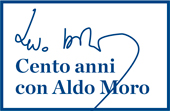Moro became President of the Council in November 1963 and kept the office through the whole legislature (1963-68), forming three consecutive governments supported by four parties (DC, PSI, PRI, PSDI); the Vice-President of the Council being the Socialist leader Pietro Nenni.
The journey was not easy: problems inside DC and two government crisis added to troubles. The first crisis (summer 1964, which also saw the veiled threat of a military insurrection) reduced the hope for the renewal which had seen the birth of the centre-left, that was shrunk to an “updated centrism” as Moro declared.
Nevertheless, governments were very active (particularly on economy, pensions, welfare, school, workers’ rights, family law), sometimes starting actions which would give results in the following legislatures.
During Moro’s governments, foreign policy (led by ministers Saragat, Fanfani and Moro himself) adopted the so-called “peace in security” stance from the Atlantic and pro-European point of view, giving particular attention to the problems of the North-Eastern border (Trieste and the question of Alto Adige).
Intervento al congresso delle Acli, Roma, 3-6 novembre 1966 Visita a Castelnuovo Garfagnana, 17 giugno 1967 Telegiornale del 20 gennaio 1968, sul terremoto in Sicilia
